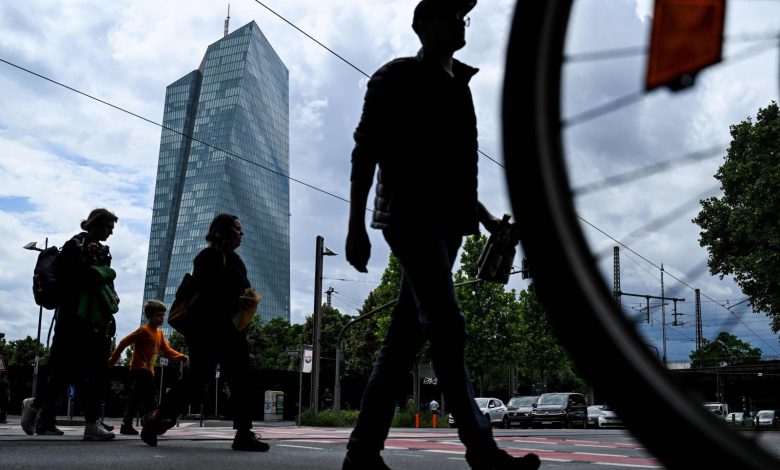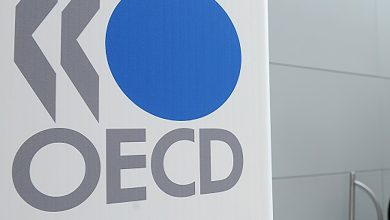Europe sees modest growth but Germany remains economic problem child

Europe’s economy experienced modest growth in the April-June quarter even as the U.S. exceeded expectations, underscoring a persistent trans-Atlantic gap with Germany, the leading European economy that continues to struggle as cautious consumers opt to save rather than spend on big-ticket items like houses and cars.
Gross domestic product (GDP), the total output of goods and services, rose 0.3% in the second quarter in the 20 countries that use the euro currency, according to official figures released Tuesday by European Union statistics agency Eurostat, beating economists’ forecasts.
The figures will likely support the European Central Bank’s (ECB) view that there is no need to rush to further lower interest rates so soon after a rate cut in June. Analysts surveyed by FactSet and Bloomberg expected growth to be 0.2%.
The expansion follows a similar 0.3% performance from the January-March quarter, the first significant growth after more than a year of stagnation just above, at or below zero.
The better-than-hoped-for growth will delight many, but concerns remain over Germany, which is weighing on the eurozone’s performance.
There have already been warning signs for the European economy, as data last week showed that business activity in the eurozone slowed further in July, with persistent weakness in the manufacturing sector.
‘Laggard’ of eurozone
Germany unexpectedly slid back into contraction, recording a 0.1% fall in output in the second quarter, the data showed.
“All in all, today’s data once again confirms that Germany is the growth laggard of the eurozone,” ING Bank’s Carsten Brzeski said.
But he added that “a rebound in the second half of the year is still possible, even though it is highly unlikely that it will be a strong one.”
In contrast, the U.S. economy grew 0.7% in the second quarter from the first quarter, or 2.8% on an annualized basis.
U.S. consumers are spending freely, while government spending from larger budget deficits and subsidies for business investment in renewable energy under the Inflation Reduction Act and in semi-conductor production and infrastructure are also contributing to the country’s growth.
Those two trends are reversed in Europe where consumers are saving at record levels and governments have started restricting spending to reduce budget deficits.
“The outperformance of the U.S. is largely due to strong private consumption and domestic investment,” said Thomas Obst, senior economist at the German Economic Institute in Cologne. “Fiscal policy support was higher in the U.S. than in other advanced economies, overall spending 25% of GDP.”
Meanwhile, higher interest rates have had less impact on lending and the economy than in Europe, he said.
France, Spain beat expectations
In stark contrast to Germany, France, the eurozone’s second-biggest economy, and Spain, the fourth, beat forecasts to grow in the second quarter by 0.3% and 0.8%, respectively.
France is currently hosting the Olympic Games in Paris, which Capital Economics said should give “a small boost” to the eurozone economy in the third quarter of 2024.
Growth in Spain, one of the region’s strongest performers, was driven by exports and strong household spending, while in France, output grew thanks to foreign trade and a recovery in corporate investment.
Southern Europe appeared to be doing better than its counterparts elsewhere on the continent.
Italy and Portugal recorded expansions of 0.2% and 0.1% respectively.
Tuesday’s data also showed the 27-country European Union’s economy expanded by 0.3% in the second quarter.
All eyes will be on eurozone inflation data for July, which will be published on Wednesday. Consumer prices remain above the ECB’s 2% target.
The lukewarm growth figure from the first half of this year follows five straight quarters of essentially zero growth caused by an outburst of inflation that robbed consumers of purchasing power. Energy prices soared after Russia cut off most supplies of natural gas in 2022 over the invasion of Ukraine, and as the global economy rebounded from the pandemic, straining supplies of parts and raw materials.
Those headwinds have eased, but Europe faces lingering effects as new labor agreements restore real wages with a lag and government support payments and tax breaks, aimed at easing, the energy crisis are phased out. Governments have shifted to trimming deficits that swelled during the energy crunch.
Higher interest rates from the European Central Bank (ECB) have helped bring inflation down from 10.6% in October 2022 to 2.5% in June – but have also held back construction activity and quashed a yearslong rally in house prices. New car sales were up 4.3% in the first half of the year from the same period last year but remain some 18% below pre-pandemic levels.
Another factor is the European consumers’ unusually high level of precautionary savings, which reached 15.4% in the first three months of the year, a record high excluding the pandemic years. Reasons for setting aside more money could be the chance to earn higher interest rates by saving, feeling poorer due to lower house prices, and fears about the future, despite low unemployment of 6.4%
The high savings rate and consumer surveys indicate that “intentions to make major purchases are extremely low,” said Jack Allen-Reynolds, deputy chief eurozone economist at Capital Economics.






